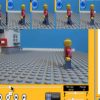Best Clay to use for Claymation Animation
best clay = best results
Producing a Claymation animation using animation software is both a fun and challenging activity. And one of the challenges that anyone can face is the actual forming and shaping of the clay characters. You will need to first mold and shape your characters before you can take any pictures and process them with your stop motion software. Creating your clay characters is similar to the art of sculpting; you have to develop and practice that artistic and creative talent to produce the best results. But of course, children will always have some limitations on the things they can create.
most expensive is better - no ?
So, should you be using the ordinary or playschool type clay when making a clay animation? Or should you be buying the best and most expensive ones available on the market when making your stop motion animation.

The General Categories of clay used in sculpting
Before answering the questions mentioned above, it is better if you familiarize yourself with the different kinds of clays used in sculpting. As mentioned above, creating Claymation characters is essentially a form of sculpture or sculpting, therefore, you need to make use of clay materials intended for this craft or art.
There are a few categories listed below and explained.

The Kiln-fired hardening clays
These types of clay require extreme heat to harden after shaping or sculpting them. The most popular example is the ceramic clay or porcelain used in pottery and producing high-gloss and colorful sculptures. They will not be suitable as you can imagine for claymation characters in general. There may be some special cases where you just might want to make a piece or part of a set or character out of such a clay but they are few and far between.

The non-hardening clays.
These are the oil-based type of clays and considered the most common used in clay animation for creating soft and movable characters. As their nature suggests, these types of clay do not harden even when heated or exposed to air and humidity for a long period of time. Instead of water, that oil component which gives its moisture prevents the clay from eventually hardening. The most popular example of this clay is the soft and colorful plasticine or plastilena clays sold on the market used by children in playing.

Oven-Baked hardening Clay
These types of clays stay In their soft and moldable state until they are baked in medium to high heat temperatures. The polymer clay that is also used in Claymation belongs to this category. Heat the shaped and molded clay and it hardens.

Air-Dryed Clay
There are also types of clays that quickly dries up after a few minutes or hours of being exposed to air. These are the water-based air-dried clays. And an example of which is the WED clay or “Plus” Clay.
These will not be suited to claymation as you want your clay to remain flexible and pliable as you animate.

The best clay for your Claymation
From the nature of the different types of clay above, the non-hardening plasticine or plastalina clay is the main clay used in stop animation. These are manufactured in different colors and stay soft and moldable even for a long period of time being exposed to air or room temperatures. But this doesn’t mean that the other clay types are not important. The hardening clays are also needed to create your Claymation characters or parts which are not movable. The hardened clay or figure will also serve as the internal support or frame of the soft plasticine clay. To simply explain, your clay animation characters will eventually have movable and immovable plays. The hard immovable parts are where the other types of clay such as polymer are best suited.
They key things to remember when choosing your in summary are :
OIL BASED
NON HARDENING
SELECTION OF COLORS
FLEXIBLE

What clay is used by Aardman for Wallace and Gromit ?
Newplast is a non drying, re-useable claymation modelling oil based clay. It is available in layered 500g bars. It is easily pliable to make a variety of clay models but is firm enough to retain its shape well for some time.
Aardman have used Newplast which is made in the UK and they have also use Van Aken (which is made in the US ). However they now use their own special proprietary mix called “Aardmix”. No one outside of Aardman is 100% sure what goes in to making it but I would suspect it is largely Newplast plus one or two extra oils to make it even more pliable.



